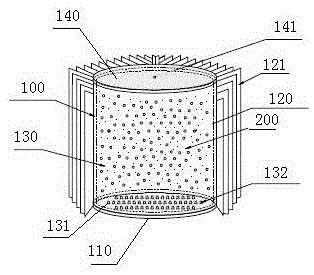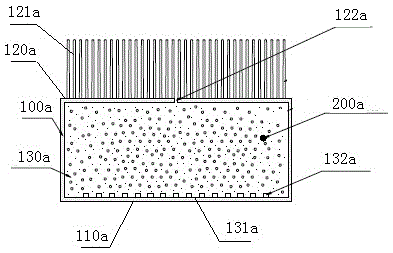Microgravity molecule heat-transferring heat conductor and application
A technology of microgravity and thermal conductors, applied in indirect heat exchangers, lighting and heating equipment, cooling/ventilation/heating transformation, etc., can solve problems such as inability to solve power dissipation above 100w, small application range, and inability to produce in large quantities. Achieve the effect of solving the problems of high-power heat dissipation and high heat flux heat conduction, unlimited scope of application, and cost-effective mass production
- Summary
- Abstract
- Description
- Claims
- Application Information
AI Technical Summary
Problems solved by technology
Method used
Image
Examples
Embodiment 1
[0028] see figure 1 , the microgravity molecular heat transfer heat conductor provided in the figure includes a cylindrical heat sink 100, the bottom surface of the cylindrical heat sink 100 is the heat absorption surface 110, and the cylindrical surface is the heat dissipation surface 120, and the heat dissipation surface 120 is set There are several cooling fins 121, and the thickness of the root and end of the cooling fins 121 is 5:2-4. The radiator 100 and the radiator fins 121 are made of 6 series aluminum. ,
[0029] A cylindrical vacuum sealed chamber 130 is provided in the radiator 100 , and the interior of the cylindrical vacuum sealed chamber 130 must be conducted. The cylindrical vacuum sealed chamber 130 is filled with the microgravity molecular heat transfer medium 200 , and the volume of the microgravity molecular heat transfer medium 200 in liquid state at normal temperature is 2 / 5 of the volume of the vacuum sealed chamber 130 . The injection method of the m...
Embodiment 2
[0035] see figure 2 , the microgravity molecular heat transfer heat conductor provided in the figure includes a rectangular radiator 100a, the bottom surface of the rectangular radiator 100a is a heat-absorbing surface 110a, and the top surface is a heat-dissipating surface 120a. The heat sink 121a, the thickness of the root and end of the heat sink 121a is 5:2-4. The radiator 100a and the radiator fins 121a are made of 6-series aluminum. ,
[0036] A rectangular vacuum sealed cavity 130a is provided in the rectangular heat sink 100a, and the inside of the rectangular vacuum sealed cavity 130 must be conducted. The rectangular vacuum sealed chamber 130a is filled with the microgravity molecular heat transfer medium 200a, and the volume of the microgravity molecular heat transfer medium 200a in liquid state at room temperature is 2 / 5 of the volume of the rectangular vacuum sealed chamber 130a.
[0037] The injection method of the microgravity molecular heat conduction mediu...
PUM
 Login to View More
Login to View More Abstract
Description
Claims
Application Information
 Login to View More
Login to View More - R&D
- Intellectual Property
- Life Sciences
- Materials
- Tech Scout
- Unparalleled Data Quality
- Higher Quality Content
- 60% Fewer Hallucinations
Browse by: Latest US Patents, China's latest patents, Technical Efficacy Thesaurus, Application Domain, Technology Topic, Popular Technical Reports.
© 2025 PatSnap. All rights reserved.Legal|Privacy policy|Modern Slavery Act Transparency Statement|Sitemap|About US| Contact US: help@patsnap.com


